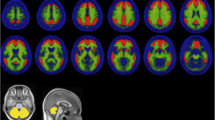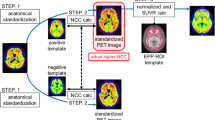Abstract
Purpose
AV-45 amyloid biomarker is known to show uptake in white matter in patients with Alzheimer’s disease (AD), but also in the healthy population. This binding, thought to be of a non-specific lipophilic nature, has not yet been investigated. The aim of this study was to determine the differential pattern of AV-45 binding in white matter in healthy and pathological populations.
Methods
We recruited 24 patients presenting with AD at an early stage and 17 matched, healthy subjects. We used an optimized positron emission tomography-magnetic resonance imaging (PET-MRI) registration method and an approach based on an intensity histogram using several indices. We compared the results of the intensity histogram analyses with a more canonical approach based on target-to-cerebellum Standard Uptake Value (SUVr) in white and grey matter using MANOVA and discriminant analyses. A cluster analysis on white and grey matter histograms was also performed.
Results
White matter histogram analysis revealed significant differences between AD and healthy subjects, which were not revealed by SUVr analysis. However, white matter histograms were not decisive to discriminate groups, and indices based on grey matter only showed better discriminative power than SUVr. The cluster analysis divided our sample into two clusters, showing different uptakes in grey, but also in white matter.
Conclusion
These results demonstrate that AV-45 binding in white matter conveys subtle information not detectable using the SUVr approach. Although it is not more efficient than standard SUVr in discriminating AD patients from healthy subjects, this information could reveal white matter modifications.




Similar content being viewed by others
References
Choi SR et al. Preclinical properties of 18F-AV-45: a PET agent for Abeta plaques in the brain. J Nucl Med. 2009;50(11):1887–94.
Carpenter Jr AP et al. The use of the exploratory IND in the evaluation and development of 18F-PET radiopharmaceuticals for amyloid imaging in the brain: a review of one company’s experience. Q J Nucl Med Mol Imaging. 2009;53(4):387–93.
Clark CM et al. Cerebral PET with florbetapir compared with neuropathology at autopsy for detection of neuritic amyloid-beta plaques: a prospective cohort study. Lancet Neurol. 2012;11(8):669–78.
Clark CM et al. Use of florbetapir-PET for imaging beta-amyloid pathology. JAMA. 2011;305(3):275–83.
Lin KJ et al. Whole-body biodistribution and brain PET imaging with [18F]AV-45, a novel amyloid imaging agent–a pilot study. Nucl Med Biol. 2010;37(4):497–508.
Wong DF et al. In vivo imaging of amyloid deposition in Alzheimer disease using the radioligand 18F-AV-45 (florbetapir [corrected] F 18). J Nucl Med. 2010;51(6):913–20.
Saint-Aubert L et al. Cortical florbetapir-PET amyloid load in prodromal Alzheimer’s disease patients. Eur J Nucl Med Mol Imaging. 2013;3(1):43.
Camus V et al. Using PET with 18F-AV-45 (florbetapir) to quantify brain amyloid load in a clinical environment. Eur J Nucl Med Mol Imaging. 2012;39(4):621–31.
Fleisher AS et al. Using positron emission tomography and florbetapir F18 to image cortical amyloid in patients with mild cognitive impairment or dementia due to Alzheimer disease. Arch Neurol. 2011;68(11):1404–11.
La Joie R et al. Region-specific hierarchy between atrophy, hypometabolism, and beta-amyloid (Abeta) load in Alzheimer’s disease dementia. J Neurosci. 2012;32(46):16265–73.
Rodrigue KM et al. beta-Amyloid burden in healthy aging: regional distribution and cognitive consequences. Neurology. 2012;78(6):387–95.
Villemagne VL et al. Amyloid imaging with (18)F-florbetaben in Alzheimer disease and other dementias. J Nucl Med. 2011;52(8):1210–7.
Villemagne VL et al. Comparison of 11C-PiB and 18F-florbetaben for Abeta imaging in ageing and Alzheimer’s disease. Eur J Nucl Med Mol Imaging. 2012;39(6):983–9.
Fodero-Tavoletti MT et al. Characterization of PiB binding to white matter in Alzheimer disease and other dementias. J Nucl Med. 2009;50(2):198–204.
Dubois B et al. Research criteria for the diagnosis of Alzheimer’s disease: revising the NINCDS-ADRDA criteria. Lancet Neurol. 2007;6(8):734–46.
Wallon D et al. The French series of autosomal dominant early onset Alzheimer’s disease cases: mutation spectrum and cerebrospinal fluid biomarkers. J Alzheimers Dis. 2012;30(4):847–56.
Fleiss JL, Nee JCM, Landis JR. Large sample variance of kappa in the case of different sets of raters. Psychol Bull. 1979;86(5):974–7.
Kyriazi S et al. Metastatic ovarian and primary peritoneal cancer: assessing chemotherapy response with diffusion-weighted MR imaging–value of histogram analysis of apparent diffusion coefficients. Radiology. 2011;261(1):182–92.
Pope WB et al. Recurrent glioblastoma multiforme: ADC histogram analysis predicts response to bevacizumab treatment. Radiology. 2009;252(1):182–9.
Pope WB et al. Apparent diffusion coefficient histogram analysis stratifies progression-free survival in newly diagnosed bevacizumab-treated glioblastoma. AJNR Am J Neuroradiol. 2011;32(5):882–9.
Conover WJ, Iman RL. Rank transformations as a bridge between parametric and nonparametric statistics—rejoinder. Am Stat. 1981;35(3):132–3.
Barthel H et al. Cerebral amyloid-beta PET with florbetaben (18F) in patients with Alzheimer’s disease and healthy controls: a multicentre phase 2 diagnostic study. Lancet Neurol. 2011;10(5):424–35.
Canu E et al. Mapping the structural brain changes in Alzheimer’s disease: the independent contribution of two imaging modalities. J Alzheimers Dis. 2011;26 Suppl 3:263–74.
Firbank MJ et al. Diffusion tensor imaging in Alzheimer’s disease and dementia with Lewy bodies. Psychiatry Res. 2011;194(2):176–83.
Vandenberghe R et al. Binary classification of 18F-flutemetamol PET using machine learning: comparison with visual reads and structural MRI. Neuroimage. 2013;64:517–25.
Kim JH et al. Regional white matter hyperintensities in normal aging, single domain amnestic mild cognitive impairment, and mild Alzheimer’s disease. J Clin Neurosci. 2011;18(8):1101–6.
Makedonov I, Black SE, MacIntosh BJ. Cerebral small vessel disease in aging and Alzheimer’s disease: a comparative study using MRI and SPECT. Eur J Neurol. 2013;20(2):243–50.
Chao LL et al. Associations between white matter hyperintensities and beta amyloid on integrity of projection, association, and limbic fiber tracts measured with diffusion tensor MRI. PLoS One. 2013;8(6):e65175.
Hong YT, et al. Amyloid imaging with carbon 11-labeled Pittsburgh compound B for traumatic brain injury. JAMA Neurol. 2014;71(1):23–31.
Gurol ME, et al. Cerebral amyloid angiopathy burden associated with leukoaraiosis: A positron emission tomography/magnetic resonance imaging study. Ann Neurol. 2013;73(4):529–536.
Casanova R, Hsu F-C, Espeland MA, Alzheimer’s Disease Neuroimaging Initiative. Classification of structural MRI images in Alzheimer’s disease from the perspective of ill-posed problems. PLoS One. 2012;7(10):e44877.
Jagust W et al. What does fluorodeoxyglucose PET imaging add to a clinical diagnosis of dementia? Neurology. 2007;69(9):871–7.
Westman E, Muehlboeck JS, Simmons A. Combining MRI and CSF measures for classification of Alzheimer’s disease and prediction of mild cognitive impairment conversion. Neuroimage. 2012;62(1):229–38.
Wolz R et al. Multi-method analysis of MRI images in early diagnostics of Alzheimer’s disease. PLoS One. 2011;6(10):e25446.
Jeon T et al. Regional changes of cortical mean diffusivities with aging after correction of partial volume effects. Neuroimage. 2012;62(3):1705–16.
Stadlbauer A et al. Magnetic resonance fiber density mapping of age-related white matter changes. Eur J Radiol. 2012;81(12):4005–12.
Watanabe H et al. Progression and prognosis in multiple system atrophy: an analysis of 230 Japanese patients. Brain. 2002;125(Pt 5):1070–83.
Acknowledgments
This study was supported by a grant from the University Hospital of Toulouse, local grant 2007, and a grant from the Agence Nationale de la Recherche. The authors thank the promoter of this study and Toulouse University Hospital.
Conflict of interest
The authors declare that they have no conflict of interest.
Author information
Authors and Affiliations
Corresponding author
Additional information
Federico Nemmi and Laure Saint-Aubert contributed equally to this work.
Electronic supplementary material
Below is the link to the electronic supplementary material.
Supplementary Figure 1
Intensity histograms of grey and white matter of an AD patient (a) and of a healthy control (b). Histograms were derived from grey and white matter probability images thresholded at 0.25, 0.50, 0.75 and 0.95, corresponding respectively to probabilities of 25 %, 50 %, 75 % and 95 % of a voxel of being in grey/white matter. No differences related to the chosen threshold are present. (PDF 358 kb)
Supplementary Figure 2
White matter mean histograms of AD (red filled squares) and HC (blue filled squares) and white matter histograms of the three AD patients and of the seven HC subjects misclassified in the discriminant analysis performed using white matter indices. The mean histograms were calculated without the misclassified subjects in each group. Vertical dashed-dotted lines in panels a and b mark 25th and 75th percentiles of histograms. (PDF 392 kb)
Supplementary Table 1
(DOCX 15 kb)
Rights and permissions
About this article
Cite this article
Nemmi, F., Saint-Aubert, L., Adel, D. et al. Insight on AV-45 binding in white and grey matter from histogram analysis: a study on early Alzheimer’s disease patients and healthy subjects. Eur J Nucl Med Mol Imaging 41, 1408–1418 (2014). https://doi.org/10.1007/s00259-014-2728-4
Received:
Accepted:
Published:
Issue Date:
DOI: https://doi.org/10.1007/s00259-014-2728-4




